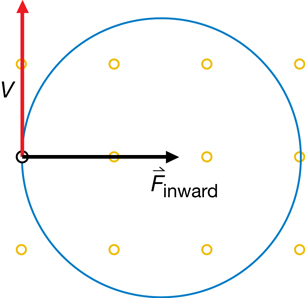Module 4
1. Module 4
1.10. Page 2
Module 4—Magnetic and Electric Fields in Nature and Technology
 Explore
Explore

© Roman Krochuk/shutterstock
In the photograph to the left, the aurora borealis lights up the northern night sky. Compare this photo with the cathode ray photos from Get Focused in Lesson 2. There are some similarities. Both phenomena are related by the motion of a moving charge in an external magnetic field. In the cathode ray pictures, the external magnetic field originates from a bar magnet and acts on moving electrons that make up the beam. Here, Earth’s magnetic field acts as an external magnet, affecting the motion of charged particles in the solar wind. The motion is very predictable but can also be complex. A simulation will be used to observe and understand the motion of a charged particle in a magnetic field.
 Try This—Part 1: The Force Exerted by a Magnetic Field on a Charged Particle
Try This—Part 1: The Force Exerted by a Magnetic Field on a Charged Particle
Open the “Particle in a Magnetic Field” simulation.
Before making any observations on the simulation, recall that a magnetic field is a vector quantity having magnitude and direction. The simulation can show three different directions for the magnetic field using the following notation, which was introduced in the tutorials of Module 4: Lesson 1.
![]() - magnetic field directed into the page/screen
- magnetic field directed into the page/screen
![]() - magnetic field directed out of the page/screen
- magnetic field directed out of the page/screen
![]() - magnetic field directed to the right on the page/screen
- magnetic field directed to the right on the page/screen
All other directions, of course, are possible but are not shown or used in the simulation.
TR 1. In the simulation, set the magnetic field direction as indicated by the small yellow arrows, dots or x’s in each image below, turn on “trace” (![]() ), and press “play.” The large magenta (purplish red) arrow is the initial velocity of the charged particle. Sketch the path of the particle on each image below:
), and press “play.” The large magenta (purplish red) arrow is the initial velocity of the charged particle. Sketch the path of the particle on each image below:
-
Which path is characteristically different than the other two?
-
In which two situations above is the magnetic field perpendicular to the particle's velocity?
-
What type of motion is exhibited when the magnetic field is perpendicular to the particle's velocity?

Figure 1
In both b. and c., the charged particle exhibits circular motion. Recall that in uniform circular motion an inward force is required to maintain the constantly changing direction of the particle. In this case, that force is acting due to the magnetic field when the charged particle moves perpendicular to the direction of the magnetic field (b. and c. above).
The inward force is illustrated in Figure 1.
If the initial velocity and magnetic field are in the same direction no magnetic force is produced, so the charge’s velocity does not change (straight line movement). If the initial velocity and magnetic field are perpendicular, an inward magnetic force will cause circular motion.
